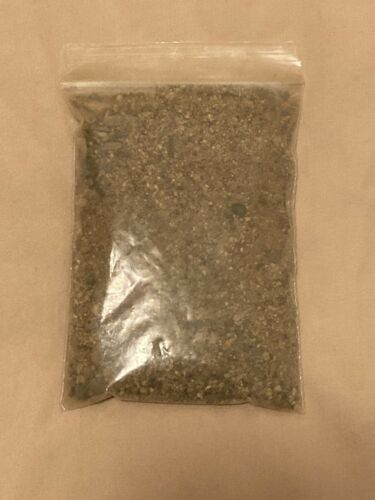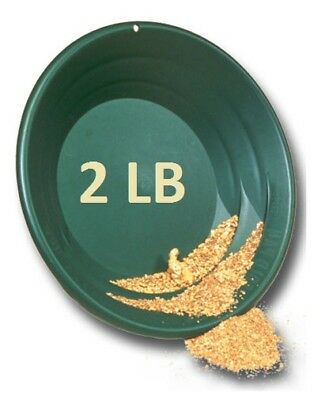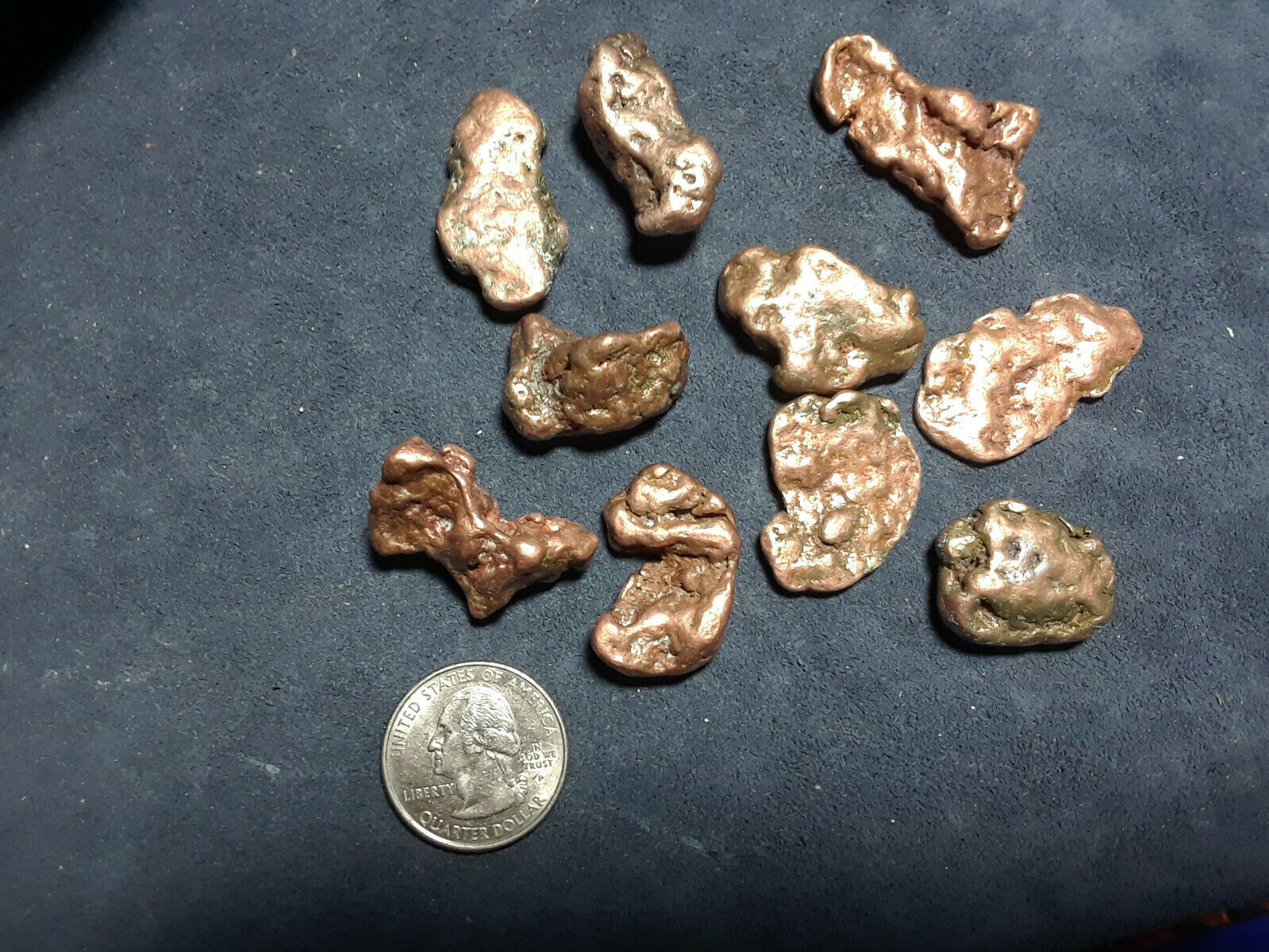-40%
BIT O HONEY GOLD QUARTZ CABOCHON 4.3 CARATS NATURAL GOLD QUARTZ GEMS
$ 68.64
- Description
- Size Guide
Description
GOLD QUARTZ CABOCHONfrom
CALIFORNIA
R
uler is
1/4"
wide (6 mm). U.S. 10 cent coin is 17 mm in diameter.
G
emstone weight:
13.4
Grains -
4.3
Carats
S
ize:
13X10.1X2.2
mm
A U.S. ten cent piece (pictured) measures 17 mm in diameter.
H
aving been a placer miner for eighteen years, gold ores were somewhat of a mystery to me. Looking at the jeweler's display case, one might think white, gold-bearing quartz was about the only kind that came from hard-rock mines. While white GQ remains the most popular color, I would not agree it's necessarily the prettiest or most alluring. 'Beauty's in the eye of the beholder', after all. This cab, comprised mostly of a light-straw-colored quartz, seems to have small bits of honey smeared around the gold. As you can tell, there's precious metal galore. This 'honey effect' results from windows of clearer quartz. Precious metal veinlets, glowing like golden algae, float lazily inside this colorful palette. The overall effect is dazzling. Cabochon hails from an unknown Mother Lode mining district. Two faces are pictured. One is slightly-domed, the other flat. Gems like this aren't made in a factory, they're created from natural gold ore. Cut, shaped, and polished, such gemstone as this is beyond rare.
U.S. S&H .00
w/tracking and insurance
Combined shipping offered. If you plan on buying more than one item from Gold of Eldorado, please request an invoice from me at checkout time
.
Check any and all
Gold of Eldorado
feedback for disputes arising from non-authenticity of the specimens I sell. All of my advertised specimens, slabs, cabochons, gold ores et al are comprised of naturally-occurring minerals (not man-made). These will contain visible native gold and/or are composed almost entirely of gold (i.e. gold nuggets, gold flakes, wire gold specimens).
T
his is the real deal...natural gold in quartz as God and nature worked it out over the millennium.
WEIGHT CONVERSIONS:
15.43 GRAINS = 1 GRAM
31.103 GRAMS = 1 TROY OUNCE
24 GRAINS = 1 PENNYWEIGHT (DWT)
20 DWT = 1 TROY OUNCE
480 GRAINS = 1 TROY OUNCE
SHIPPING .00
(includes USPS tracking and insurance to all U.S. destinations)
COMBINED SHIPPING DISCOUNT OFFERED FOR MULTIPLE ITEM PURCHASES. WHEN CHECKING OUT, PLEASE REQUEST AN INVOICE FROM THIS SELLER
INTERNATIONAL CUSTOMERS S&H .00
shipped via USPS 1st Class parcel.
FAST REFUND OFFERED
(If, for any reason, you're not happy with this item)
We leave no stones unturned insuring our customers get what they bargained for.
If you're not satisfied with this item, contact me. Then, if the problem can't be fixed, return product within 30 days in 'as purchased' condition for a full refund.
PAYMENTS
For U.S. buyers: We accept paypal.
For intnl. customers: We accept paypal
Pay securely with
www.paypal
.
Payment must be made within 7 days from close of auction. We ship as soon as funds clear. If you have questions, please ask them before bidding.
THE WORLD OF GOLD QUART
Z
W
elcome to the world of Natural Gold Quartz. For those of you unfamiliar with this product, GQ is, essentially, gold ore, very high-grade gold ore found in the outer crust of the earth. When geological conditions are just right, metallic gold-crystals lithify (harden), along with quartz, in fissure-type veins and various rock formations. This occurs as boiling hot, hydrothermal solutions full of silica and metal cool. It was once thought that most precious metals deposits formed beneath the ocean, but in more recent times, it was discovered that geothermal hot springs well-above sea level have been producing ore bodies of tremendous size. Since most of the gold recovered from these types of deposits is micron in size, placer deposits are not typically associated with such lodes. Where prominent, gold-bearing, fissure-type veins exist, however, erosion weathers richer portions of these ore bodies to form gold nuggets, gold flakes, flour gold, and even finer 'free gold'. Vein filling which retains the host matrix rock (gangue) and harbors metalliferous gold can become one of the earth's more highly-prized gemstones.
The ideal criteria for this gemstone type are hardness, color, and richness.
The best grades of gem rock are very hard, unbrecciated, and contain minimal cracks or fissures. Cryptocrystalline quartz/gold, where it exists, is highly-prized by gemologists/lapidaries/jewelers/and collectors. Overall mineral compositions and characteristics of gold-bearing stone found in fissure veins
(and larger ore bodies) vary from one deposit to the next. This results in the formation of differently-colored matrix (host rock). The gemstone offered here is just one more example.
The metallic mineral, gold, occurs in a variety of geological formations. In modern-day mining operations, entire mountains are blasted down, transported and piled into heaps, then soaked with cyanide to leach the precious metal from the ore. A century ago, it was much more likely that prospectors would have sunk a vertical shaft into an ore outcropping or have attempted to follow a horizontal or diagonal lead/ledge/lens/vein into a mountainside. Once extracted from the mine-shaft, recovering the gold locked inside the ore was very labor intensive. Arrastras were one of the earlier crushing devices used for pulverizing and removing gold from such ore. Stamp mills, even more labor-intensive albeit more productive, soon followed. An old time prospector's first inkling of a lode occurrence would more than likely have been the discovery of a quartz vein. A rich placer deposit holding coarse, gnarly, even crystalline gold along with gangue would also have been strong evidence that a vein system was in the proximity.
Quartz veins, at one time, were notoriously famous producers of gold, but many prominent, fissure-type, lode deposits such as the one at the Homestake Mine in South Dakota and California's Sixteen to One Mine were followed to great depth. Since ore grades rarely remain consistently uniform throughout the life of a mine and veins are displaced by the continual movement of the earth's crust, deep deposits, at some point, may be lost or simply become unprofitable to mine. Water seepage was often a major problem in many of the historic old mines of the western U.S.
Sometimes, a productive vein decides to slip. It doesn't do this overnight. As a result of geological shifting in the earth's crust, discontinuous veins often slip sideways to other positions and, in that manner, are lost. Prices for metals fluctuate dramatically. A great many factors influence the availability, production, and profitability of gold quartz gemstone. GQ appears to be extremely scare at this time since only a scant handful of mines around the world are producing this rare gemstone material. Even when a new high-grade ore deposit is discovered, collectors and dealers are tasked with procuring something not being publicly offered or made available. I am making this available.
Thanks for checking out our digs.
G
old of
E
ldorado
8-19-10















